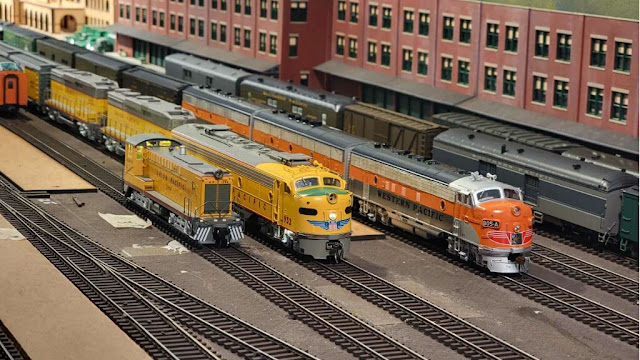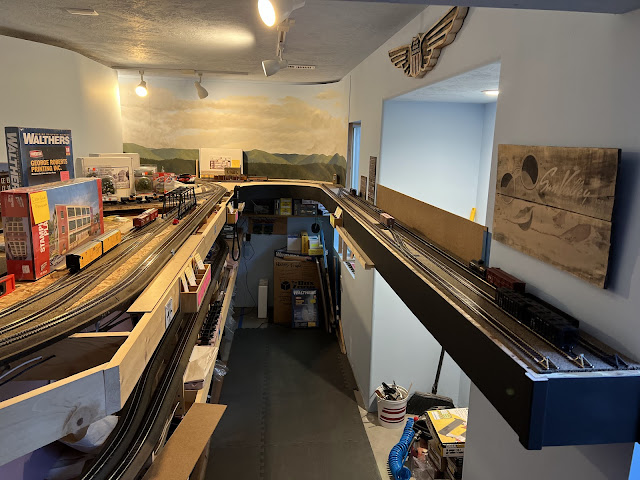In conversations with other model railroaders recently, the topic of designing and building a new layout came up a few times. These conversations provoke reflection on how to design a layout, and how I probably would have done things differently if I had it to do all over again knowing what I know now. The first principle of designing a layout is its concept and operation, starting with the question 'is the layout a journey or a destination?' How one answers this question determines the rest of the design. A 'journey layout,' as the label says, models the route trains take to get from point to point, usually emphasizing mainline operations. A 'destination layout' models a particular place - a city, a branch, a function such as a yard or a terminal - and emphasizes switching as is primary operation.
Mine, a freelanced two-hub operation on two levels is a destination layout.
It centers on two endpoints: California and Oregon, each with a passenger terminal and local freight handling. It's all about switching, and its reputation is a passenger switching layout. Yes passenger switching. This operation allows operators to experience all the unique aspects of passenger trains in a compact space and is an aspect of passenger service that seldom, if ever, gets the attention of model railroaders. Upon seeing this operation most visitors pick up on its uniqueness, noting that they have never seen or thought of passenger switching as an operation. They say that they're used to 'passenger trains just going around the layout' doing not much of anything but get in the way of the freight operation.
But there is freight operation, and plenty of it. That's the beauty of a destination layout concept: it provides the best of passenger and freight operations all together in one place, making the best use of the compact space of a typical room-sized layout. And now the layout has freight operations completed on the entire main level (track, industry spots and job assignments at least).
 |
| It's a busy day at Cascadia Union Station, where 7 railroads interchange mail, express, sleeping car, and general passenger service. |
Here are the vital stats of freight operations:
- Downtown Cascadia: The largest freight operation, Downtown Cascadia serves 12 freight customers, including a large freight house, with 40 car spots. A stubbed freight yard serves this operation with 3 freight trains (SP, WP, GN) providing its mainline feeder service.
- Northern Pacific Branch: Including a small town and unincorporated area, this local takes half the main peninsula and serves a brewery, produce market, light manufacturing in town, while the unincorporated area in the foothills serves a lumber yard, cement distributor and small local mill/grain dealer. This town has a small holding yard on the marshy wetlands and a freight house for handing LCL (less than carload) and express freight.
- Studerville Local/Cascadia Transfer: Served by Great Northern, this freelanced small agricultural town in Southern Washington centers on a fruit packing house (apples primarily) with a furniture maker and brewery filling out its complement of industries. Having a depot house track for setting out express refrigerator cars bound for California and an occasional through sleeper, this line transfers freight through Cascadia to points south and to the Washington staging yard.
- Washington Staging Yard: Mirroring the Cascadia Yard (see picture below) on the opposite end of the layout, this 3 track yard classifies and stages freight for the Washington and Northern Oregon Districts of the Hill Lines (Great Northern, Northern Pacific Spokane Portland & Seattle and, via trackage rights, Union Pacific and Milwaukee Road). Each local train has a dedicated track, with the third track providing overflow and the SP&S passenger local, 'Columbia River Express.'
Summary and Observations:
Photo Album
 |
| West Sellios, the small town on the joint GN/NP mainline has a yard and 8 local industries. |
 |
| Future road leading into the outskirts of the small town crosses the Northern Pacific mainline and continues with cement plant and grain mill in the distance. |



Comments
Post a Comment